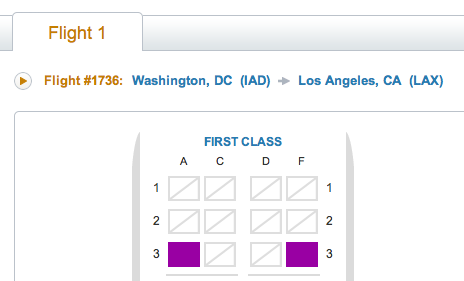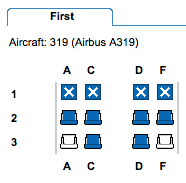In the world of available seats on airlines – whether it be for upgrades or seats for sale – there’s a lot of places to look for information on how many seats are truly available.
Sure, you can get a paid subscription to a service like ExpertFlyer, which shows you the availability in inventory, but for many folks, getting such a subscription isn’t worth it to them, or is too expensive.
That said, for many people, they use airline seat maps to look at how many seats are available on a flight…which is totally the wrong way to do it.
Let’s look at the morning non-stop Washington Dulles to Los Angeles route.
If I want to see my upgrade chances on this route, and didn’t know better, I would probably look at the seat map to see how many seats are open.
Clicking on the seat map, I see only two open seats. Bummer. Looks like the upgrade chances aren’t too good. Or is it?
Looking at the inventory for this flight, we actually see that there’s still 6 seats for sale in First Class (“F6”). To do this, I pulled this data from Expert Flyer, though technically you could continue to search for First Class seats like you’re booking a ticket until you run out. In other words, search for 1 seat, then 2 seats, then 3 seats, etc., until it shows nothing left for sale.
So, you can obviously see the deception here. Off the cuff, it seems like only 2 seats are available, but pulling the availability data, we actually see 4 extra seats.
When we pull up the seat map on ExpertFlyer we see the reason why we only saw two seats to begin with. 3A and 3F are truly open, while everything in row 1 is blocked for airport control. These seats are still available for sale, but not able to be assigned yet. Traditionally, they’ve been blocked to assign to elites at the gate, though sometimes it doesn’t work out that way,
The same strategies apply when looking at seats in coach. Sure, you may only see one seat for assignment, but there many be 10 seats still for sale.
The lesson here is to really know your data, rather than trust the airline seat map, which is often deceiving. For the person that doesn’t fly that much, the airline seat map is an intuitive tool you’d think would provide correct information, but is often grossly incorrect and deceptive based on assigned seats and inventory.
UPDATE: Gary Leff, author of View from the Wing, has pointed out in the comments how using seat maps can be useful, and he’s 100% right, which I failed to point out. Let’s use American as the example here – they often have no seats left for sale, but still a greater amount of seats for assigning, which can indicate great upgrade opportunities, if you’re watching. Actually, more often than not, this is how last minute upgrades will work, since you’ll see more seats left open on the map rather than using a back-end program such as ExpertFlyer. As Gary points out, while some reservations may not have assigned seats at booking, this is becoming increasingly rare, as more reservations either become auto-assigned, or people become more consciously aware and go in to assign seats on their own.
Do you ever trust an airline seat map to provide availability data or do you use a paid subscription service?






 Jamie Larounis is an avid traveler, blogger and miles/points educator. Traveling well over 100,000 miles a year and staying in hotels for over 100 nights, he leverages miles, points and other deals to fly in first class cabins, and stay in 5-star hotels. The Forward Cabin shares his experiences, musings, reviews, tips, tricks, resources and industry news with you, the fellow traveler.
Jamie Larounis is an avid traveler, blogger and miles/points educator. Traveling well over 100,000 miles a year and staying in hotels for over 100 nights, he leverages miles, points and other deals to fly in first class cabins, and stay in 5-star hotels. The Forward Cabin shares his experiences, musings, reviews, tips, tricks, resources and industry news with you, the fellow traveler.
The seat map can be very useful. For instance, there may be more assignable seats available than for sale. Of course there may be people with reservations but not seat assignments, that’s increasingly rare especially for domestic travel. Instead, American frequently lists fewer seats for sale than are available in the cabin especially for hub departures later in the day in order to accommodate potential irrops. So a flight might be F2 but have 6 open seats! Much better change of upgrade. It may even be F0 but not sold full.
Ah, very true. I should have pointed this out. I see this ALL the time on American. Actually, that’s the saving grace when it comes to upgrades sometimes. Excellent points.